Film vs digital - What is Hollywood shooting on?

John from Israel emailed me to ask what format most Hollywood films are shot on - film or digital. The question is rather topical as recently we've seen a number of high profile films choose to shoot on film, including Star Wars: The Force Awakens and The Hateful Eight.
I looked at the cameras used to shoot the top 100 US-grossing films for each year over the past two decades (1996 to 2015 inclusive).
Film vs digital among Hollywood movies
The first year in which top-grossing films were shot on digital cameras was 2002, however it wasn't until 2012 that at least half of the films were shot digitally.
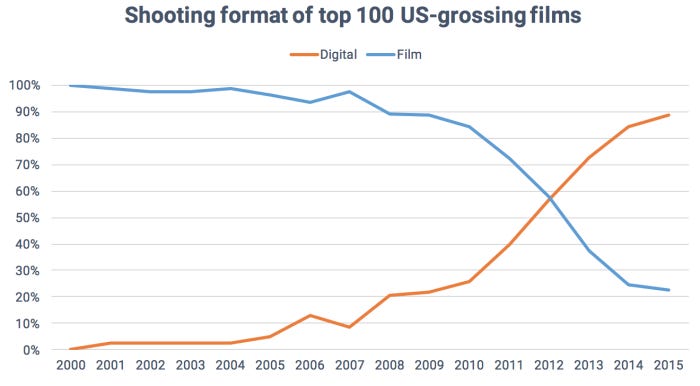
Sci-fi movies are twice as likely to be shot digitally compared to War films.
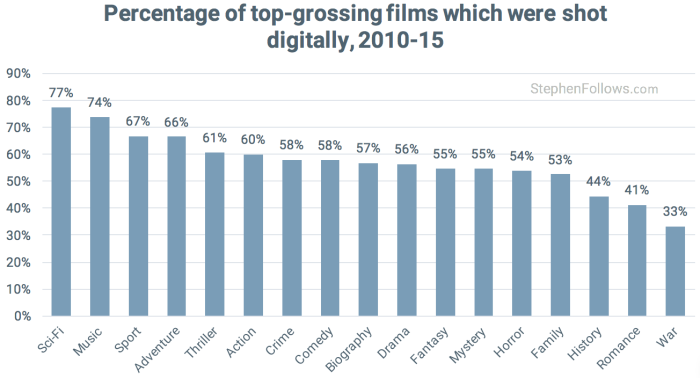
I showed these stats to a friend who is a Director of Photography and his thoughts were "History films shoot film more because it's softer and people associate it with a period look now and Romance because film still makes actors look more attractive than digital".
Which film sizes are used in Hollywood?
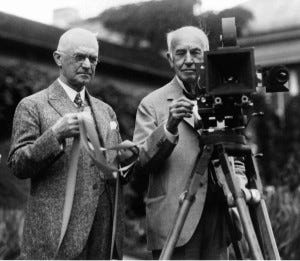
The biggest differences between film cameras is the type of film you want to shoot on - the larger the film frame, the better quality the image as there is more space to capture detail. The most common formats include...
16mm - The smallest size used on professional Hollywood movies is Super 16mm, which will be used either when the filmmaker wants a gritty look or in an effort to save money. It was used on films such as Leaving Las Vegas, Evil Dead and Chasing Amy.
35mm - The traditional film stock used by the vast majority of movies which shoot on film.
VistaVision - VistaVison uses normal 35mm film stock but runs it sideways to give 65% more space to each image.
65mm - Used mostly by directors who have the power to demand the extra budget needed (such as Paul Thomas Anderson's The Master and Tarantino's new flick The Hateful Eight) or when the final movie will be distributed on IMAX screens.
70mm - Film stock which is twice as big as big as 35mm. Films projected on 70mm are normally shot on 65mm and blown up to 70mm.
The bigger the film size, the more it will cost (to buy and process) as well as adding size and weight to the cameras you need to use.
Which digital cameras are used in Hollywood?
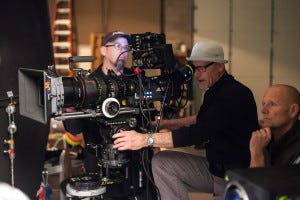
When it comes to digital cameras there are so many different variables that it can make your head spin. There's the frame size (i.e. 2K, 4K, etc), the level of compression (i.e. trying to make best use of hard drive space without compressing the image noticeably), chroma subsampling (which is labeled as 4:4:0, 4:2:2, 4:2:0, etc and is a complex topic - it looks at the level of detail you're capturing by three different measures.).
The lowest-priced cameras which were used on my dataset of 2,000 top US-grossing Hollywood films are GoPros (from around £250) and Canon EOS (from around £2,000). The GoPro is a tiny, light, durable camera which was designed to capture footage that's impossible with normal cameras (i.e. action sports) and the Canon EOS cameras are essentially souped-up digital stills cameras. At the other end, a new RED Scarlet Dragon will set you back around £8,600 and a Sony PMW-F55 CineAlta will cost from £20,000. Most of these prices are purely for the camera body, which means you need to also buy matte boxes, lenses, viewfinders, batteries, hard drives, etc.
The most commonly-used digital camera was the Arri Alexa, followed by the RED Epic and the Sony CineAlta.
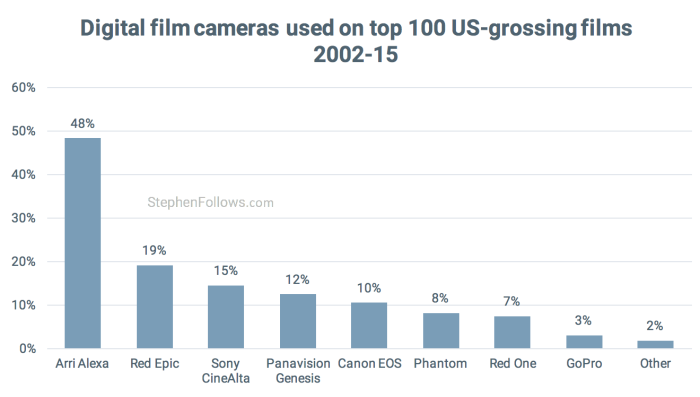
Out with the old...
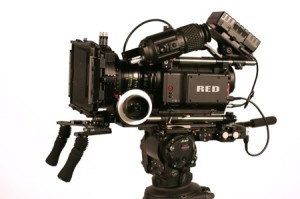
The life cycle of digital cameras is much quicker than that of older film cameras. I shot an IMAX film a few years ago and we used a VistaVison camera which was over 40 years old. By contrast, take a look at the lifespan of the RED One...
March 2007 - The RED One was first tested professionally by Peter Jackson in March 2007 on a short film called "Crossing the Line".
August 2007 - The first batch of cameras were released to the public.
February 2008 - 'Jumper' released in cinemas, featuring 2nd Unit footage shot on the RED One.
Films released in 2009 - 10% of the top 100 US-grossing released in 2009 used a RED One for some of their shots.
Films released in 2012 - The RED One has been fully replaced by the RED Epic among top 100 US-grossing films.
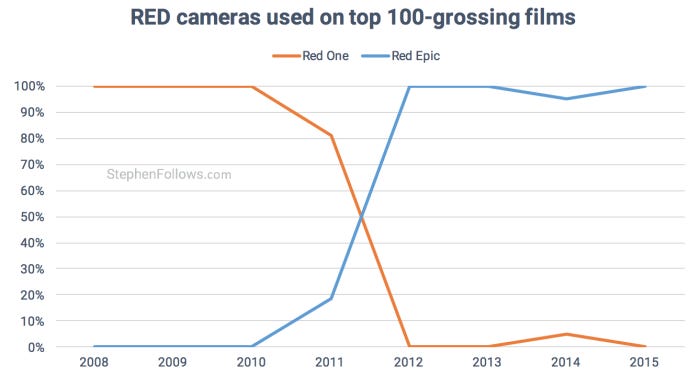
Aspect ratio of Hollywood movies

Regardless of whether productions choose to shoot on film or digitally, they will also have to pick an aspect ratio. This is the ratio of the width of the frame to the height, commonly expressed as a ratio such as 1.85 : 1. In the early days of film, movies were 1.33 : 1 (also called 4:3) which is close to being a square frame. However, when television came along and used the 4:3 format, Hollywood looked for new ways to make the cinema look bigger. They experimented with ever-wider formats, including ToddAO (2.20 :1), CinemaScope (2.35 : 1), anamorphic (2.39 : 1 ) and Cinerama (2.59 : 1) to name just a few.
Most normal Hollywood movies decided on 1.85 : 1, which become the defacto standard from the mid 1950s up until around 2000. However, television started to copy the widescreen format, with 1.77 : 1 (also known as 16:9) becoming the normal for DVDs, Blu-ray and television broadcasts. From my research below, we can see that in response Hollywood has done what it did last time television stepped on its turf - it got wider.
Over two thirds of the top 100 US-grossing Hollywood films are now shot in 2.35 : 1, with under a third being released in 1.85 : 1.
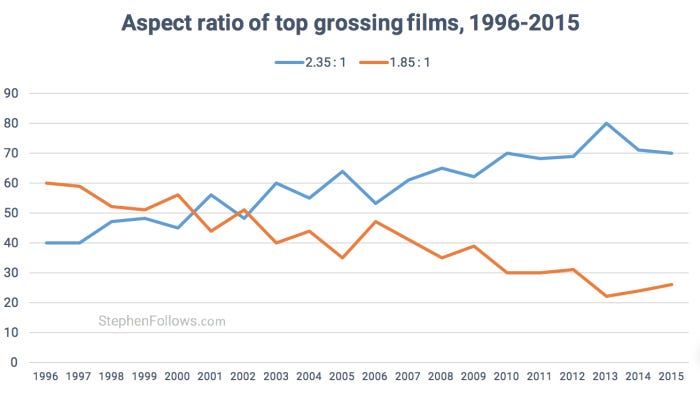
If you would like to know more about Hollywood aspect ratios then I highly recommend this fun, fact-packed video from FilmmakerIQ called 'The Changing Shape of Cinema: The History of Aspect Ratio'.
Methodology and notes
Here are some notes on today's findings...
The data came from IMDb and Wikipedia, both of which rely on user-submission, therefore we cannot be sure it's complete and up-to-date.
Across the twenty-year period, I found data on 84% of films, and the percentages in the charts above relate to the films for which I have data (i.e. 100% represented all of the films I have data for, not all of the top-100 films that year).
Some films use more than one type of camera, although cannot know to what extent each camera is used. Therefore, if a film was shot primarily on 35mm but had one dream sequence shot digitally then in this research it would appear on both the 'film' and 'digital' lists.
I've grouped the Canon EOS cameras together as they are a very different type of camera compared to the Arri Alexa et al and because if I didn't then they would all get lost in the 'Other' category. The 'Canon EOS' category includes 5D Mark II, 5D Mark III, C500, 1D Mark II and the 7D.
Epilogue
Over the holiday period I have achieved two things - I watched every episode of Game of Thrones from start to finish and I got close to finishing my report on female directors in the UK film industry. The negative way it portrays women in its chaotic male-centric world was tiresome, so it was good to have Game of Thrones for light relief.
The report is for Directors UK and will be published in mid-February at the Berlin Film Festival. I'll be sure to share my findings on this blog too.


